#freshwater fauna
Text
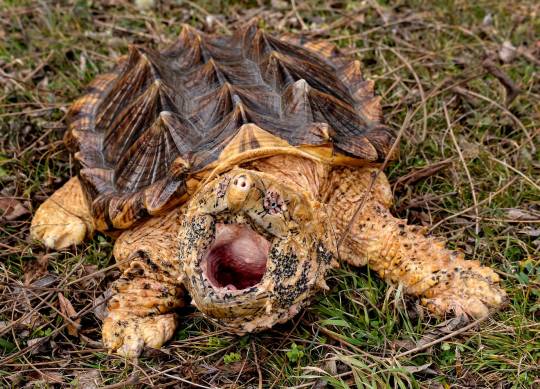


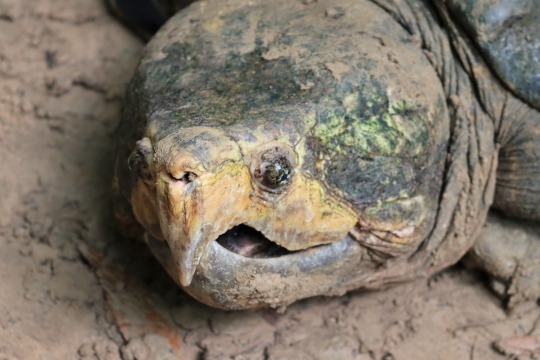
The Stupendous Alligator Snapping Turtle
Alligator snapping turtles (Macrochelys temminkii) are one of three recognised species of snapping turtle, all of which are found in North America. This particular species is found in the southeastern United States and the Mississippi Basin in particular. Macrochelys temminkii prefers deep freshwater, and is especially common in deep rivers, wetlands, and lakes.
The alligator snapping turtle is the largest freshwater turtle in North America, and is one of the heaviest in the world. Most individuals weigh between 70-80 kg (154-176 lbs), and are about 79-101 cm (31-39 in) long. However, the largest verified indiviual weighed over 113 kg (249 lb), and many others have been recorded in excess of 100 kg. The species is easily identifiable by its large, boxy head and thick shell with three rows of raised spikes. Typical alligator snapping urtles are solid black, brown, or olive green, though the shells of many older individuals can be covered in green algae.
M. temminkii is famous for its strong bite, which is most often utilised when feeding. The turtle's tongue resembles a worm, and at night individuals lie on the bottom of the river or lake bed with their mouths open. Fish are enticed by the bait-tongue, and when they get close enough the alligator snapping turtle's mouth clamps down around them. In addition to fish, this species may also feed on amphibians, invertebrates, small mammals, water birds, other turtles, and even juvenile alligators where their territories overlap. The alligator snapping turtle's relies on ambush techniques, and so hunters can remain submerged for up to 40 minutes. In some cases, individuals can also 'taste' the water to detect neaby mud and musk turtles. Because of this species' thick shell and ferocious bite, adults have few predators, but eggs and hatchlings may fall prey to raccoons, predatory fish, and large birds.
This species spends most of its time in the water, only emerging to nest or find a new home if their current habitat becomes unsuitable. Mating occurs between Februrary and May, starting later in the northern regions of the species' range. Males and females seek each other out, but generally don't travel great distances. About two months after mating, females dig a nest near a body of water and deposit between 10-50 eggs. Incubation takes up to 140 days, and the average temperature of the nest determines the sex of the hatchings; the hotter it is, the more males are produced. In the fall, hatchings emerge and are left to fend for themselves. Sexual maturity is reached at between 11 and 13 years of age, and individuals can live as old as 45 years in the wild.
Conservation status: The alligator snapping turtle is listed as Vulnerable by the IUCN. The species is threatened by overharvesting for meat and for the pet trade, and by habitat destruction.
If you like what I do, consider leaving a tip or buying me a ko-fi!
Photos
Ed Godfrey
Cindy Hayes
Eva Kwiatek
Nathan Patee
#alligator snapping turtle#Testudines#Chelydridae#snapping turtles#freshwater turtles#reptiles#freshwater fauna#freshwater reptiles#lakes#lake reptiles#wetlands#wetland reptiles#rivers#river reptiles#north america#southern north america#animal facts#biology#zoology
455 notes
·
View notes
Text
Wind: We can handle it, hang back if you wish.
Ravio: Don't you worry, I've had my fair share of tussles.
Wind: Like the mushroom?
Hyrule: Those are truffles.
Wind: Like the sprout?
Twilight: Those are brussels.
Wind: Like the trout?
Legend: THAT'S A FISH!
#legend don't pout#source: rwby#sailor boi still learning forest/freshwater flora and fauna#linked universe#lu#linkeduniverse#lu twilight#lu wild#lu wind#lu hyrule#lu legend#lu ravio#lu rambles#linked universe incorrect quotes#lu incorrect quotes
244 notes
·
View notes
Text
me: hey guys look at these mussels
apparent world expert on freshwater mussels: what the fuck is that
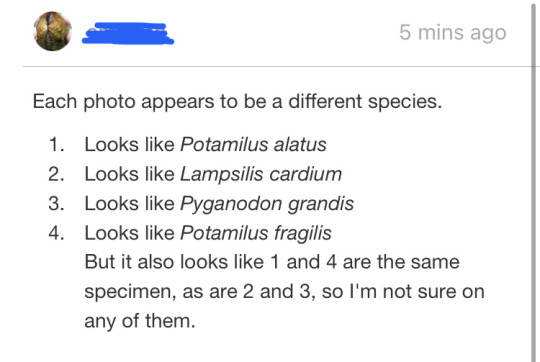
#flora and fauna#if anyone ELSE knows everything about freshwater mussels im right here and my phone is absolutely full of images to look at
9 notes
·
View notes
Text
Environment: Every Drop Counts in America’s Waterways Crisis
The Rio Grande and Colorado Rivers are two of the most threatened rivers in the U.S. National Geographic Photographer Pete McBride is on a mission to protect these vital rivers and their ecosystems.
— July 25, 2023 | Photographs By Pete McBride | By Kathleen Rellihan
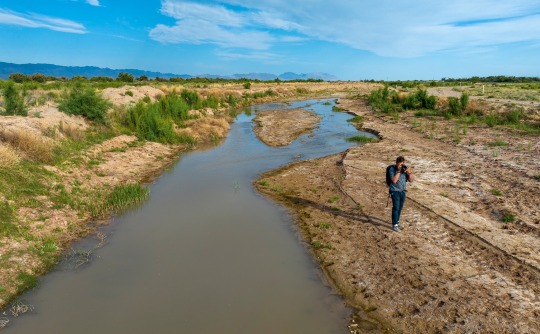
National Geographic Photographer Pete McBride went on assignment to the Rio Grande to capture imagery of the depleted waterway.
Our nation's most vital waterways are drying up at an alarming rate due to global warming, increased human water use, and other man-made impacts. Nowhere is this crisis seen as dramatically than in the American West, with its longest drought in 1,200 years. Two of our nation’s critical lifelines—the Rio Grande and the Colorado River—are shrinking tragically with every passing day.
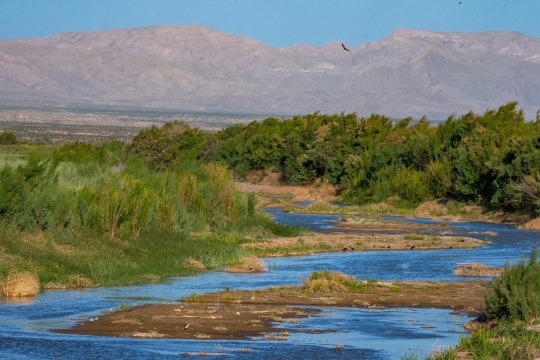
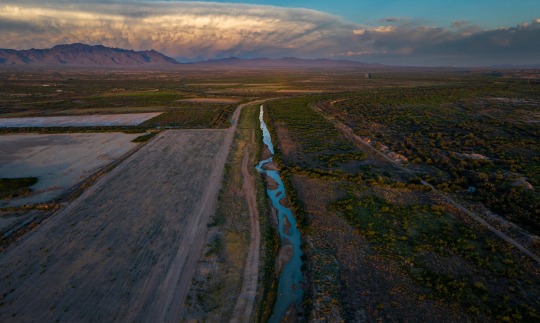
The Rio Grande is one of the most threatened waterways in the United States.
After spending years traveling the world on assignment, National Geographic Photographer Pete McBride realized that the world’s natural places he spent years documenting were changing drastically due to the disappearance of freshwater. He has spent the last two decades trying to bring awareness to this issue through photography and storytelling. Still, McBride calls for individuals and companies to take action to save our rivers and water.
“I hope to make people more aware of how fragile and precious our freshwater systems are—and why we all need to care for them like beloved family members. When we ask too much of them, they simply disappear.”
— Pete McBride, National Geographic Photographer and Explorer
Now, an effort from Finish Dishwashing is also helping to raise awareness of the crisis affecting freshwater resources everywhere. The Finish brand worked with a Texas sculptor to craft a one-of-a-kind sculpture that depicts the very thing it is honoring. Made from limestone that is native to Texas, the monument draws inspiration from rock formations, waterflow, waterfalls, flora, and fauna unique to many of the endangered bodies of water in the Southwest. Placed at the bottom of a lake in an at-risk area in Texas, the HOPEFUL MONUMENT is the first monument created with the hope that it will never be seen—that is, it will not be revealed unless water levels drop drastically low. While most monuments commemorate the past, this one is meant to spur action for the future—to inspire us to protect our most precious resource: water.
“Our drinking water doesn’t come from the tap, but rather rivers and lakes which supply the vast majority of all our water systems. Without them, then our taps will, and they already are, run dry and/or be polluted,” says McBride.
— Pete McBride, National Geographic Photographer and Water Advocate
McBride knows firsthand about the water crisis in the West, as he has documented it in his award-winning film, Chasing Water, and book, The Colorado River: Flowing Through Conflict. A photographer and Colorado native, McBride's mission is to raise awareness for the Colorado River and all American rivers, or arteries, as he refers to them.
After witnessing a dramatic loss of water in the Colorado River near his home, McBride expanded his photography career to be one that’s focused on environmental advocacy to protect the threatened resources of his home region, the American Southwest.
“I hope that combining beautiful imagery and a human story around a tough subject will help the public become more inspired to understand the issue and become more active,” says McBride, who was named a National Geographic Freshwater Hero for his work documenting rivers worldwide.
The National Geographic Photographer says he’s a “curious citizen who cares about his backyard river” and called to protect the waterway. And he’s now calling everyone else to do their part as well.
A Vital River Under Threat: The Rio Grande
On McBride’s latest assignment in Texas, he’s standing in a dried-up riverbed in the Rio Grande River, a spot locals tragically refer to as the “Rio Sand.” Just an hour south of El Paso, America’s fourth longest river is only ankle-deep in some locations. As it flows further south along the U.S./Mexico border, the river will become a trickle—and in many places—it runs completely dry.


The Rio Grande is dotted by dry stretches throughout Texas.
The Rio Grande supports more than 16 million people in the US and Mexico, including 22 indigenous nations. Alarmingly, this vital river system in North America is vanishing at a dramatic rate. Flowing from the Rocky Mountains and later forming the U.S.-Mexico border, this threatened river and its ecosystems have been impacted by agriculture withdrawals, rising temperatures, and unprecedented drought.
“The Rio Grande, just east of El Paso, is the ‘forgotten reach’—by the time it gets here it's a ghost of its former self. Because of a changing climate, severe drought, and asking too much of this limited resource, it's completely drying out.”
— Pete McBride, National Geographic Photographer and Explorer
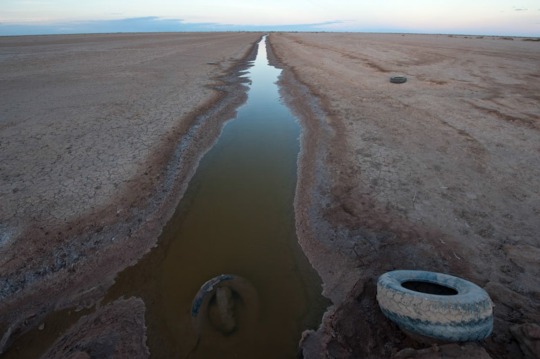
The Rio Grande has seen devastating impacts from climate change. New Mexico, like much of the West, has been battling unusually hot and dry weather for the last two decades. The river has also been hit by historic drought, with the lower Rio Grande, the border between Texas and Mexico, dried up for over a hundred miles.
“Fresh water is one of the most important, limited natural resources,” says McBride as he stands in the barren riverbed. “We can live without oil; we can't live without water.”
America’s Most Endangered River—The Mighty Colorado
Seeing firsthand his own home dry-up in the water crisis had a major impact on the National Geographic Photographer: “I grew up on the [Colorado] River, so I always had a fond love for its beauty and wonder. When I followed it to its end and saw it run completely dry, I realized there needed to be more voices speaking on behalf of the river itself.”
The “lifeline of the West,” as the Colorado River is known, supplies drinking water to 40 million people in the U.S., fuels hydropower in eight states, and is a critical resource for 30 tribal nations and agricultural communities, according to the Bureau of Reclamation. It’s also the most at-risk river in the U.S. and is now considered the most endangered river in the world by conservation nonprofit American Rivers. The once mighty Colorado River has been drying out for the last twenty years due to overuse and historic drought.


Due to overallocation and climate change, the Colorado River has not reached the sea for two decades.
“The Colorado River is the frontline of climate change,” says McBride. “This remarkable river system supports over 5 million acres of farmland, where 95 percent of our winter vegetables come from. If you like eating salads, you are eating the Colorado River.”
As the climate crisis worsens, the water levels plummet. Today, the Colorado River runs at only 50% of its traditional flow, while its largest reservoirs in the United States: Lake Powell and Lake Meade, fell to 22% during the fall of 2022.
Everyday Actions to Save Water
The water crisis is a daunting and undeniably complex issue, but that doesn’t mean that people in their daily life can’t help protect our most valuable resource. If we don’t take action now, there won’t be time to save these rivers, lakes, reservoirs, and other bodies of water, warns McBride.
“Become more aware of your waterways. Our voices can make a difference. Rivers need more advocates,” advises the National Geographic Explorer, adding, “You can use less water by reducing meat consumption (meat requires a lot of water to produce), using less water-intensive, non-native thirsty plants in your yard, like bluegrass, and reducing how often you run your water systems for dishes, etc. We need agriculture as we need to eat; we just need to become more efficient and mindful about everything: from what is on our plate to how we clean them and use our taps."
McBride believes these are just some of the everyday actions we, as consumers, can take. Another small change that will make a ripple of impact? Use your dishwasher and stop pre-rinsing. Finish agrees. The brand has a longstanding history of driving impact and inspiring change through its ‘Skip the Rinse’ purpose campaign, which encourages consumers to skip pre-rinsing their dishes before placing them in the dishwasher, ultimately saving up to 20 gallons of water each time. If we all skipped the rinse, we could save up to 150 billion gallons of water every year.
Other water-saving actions include turning off the shower/faucet while lathering or brushing teeth and installing a greywater recycling system.
“Our fresh water is a limited resource,” warns McBride. “If we don’t get involved on some level, we will [see] more of that resource vanish.”
#Environment#Waterways Crisis#Rio Grande & Colorado Rivers#U.S. National Geographic Photographer Pete McBride#Kathleen Rellihan#American West#Hopeful Monument#Texas Native Limestone#Rock Formations | Waterflow | Waterfalls | Flora and Fauna#McBride: National Geographic Freshwater Hero#Rio Sand#El Paso#U.S. 🇺🇸/Mexico 🇲🇽 Border#Indigenous Nations#Rocky Mountains ⛰️#Agriculture 👨🌾#Hydropower#Tribal Nations | Agricultural Communities#Overuse of Waters | Historic Drought#United States 🇺🇸: Lake Powell | Lake Meade#National Geographic Explorer#Shower/Faucet#Greywater Recycling System#Resource Vanish
0 notes
Text
Today I want to talk about the Pacific Northwest Tree Octopus (Octopus paxarbolis).
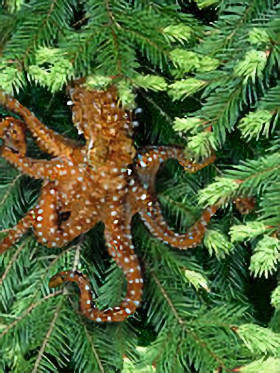
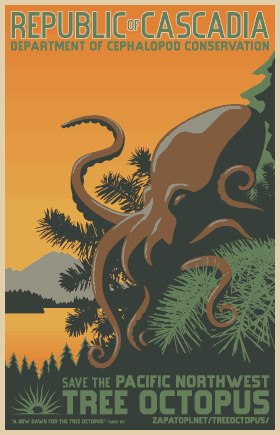
OK, so for those who don't know, the PNW Tree Octopus was an internet hoax created in 1998 consisting of a website detailing the animal's life history and conservation efforts. It's completely fake - saying that up front. This animal never existed.
But if you look at this from a speculative biology standpoint? It's genius.
There is one, and only one, thing preventing Octopus from colonizing and being hugely successful in terrestrial environments in the PNW, and that's the fact that no cephalopod has ever been able to overcome the osmotic stress of inhabiting freshwater. We don't know why this is; other mollusks evolved freshwater forms just fine. But if you hand-wave away that one, single limiting factor, the PNW is just primed for a terrestrial octopus invasion.
The Pacific coast of North America is an active tectonic boundary, meaning the coast transitions pretty much immediately into the Cascade and Coastal mountain ranges (contrast with the east coast and its broad Atlantic plain). It's also a lush temperate rainforest, with very high precipitation. This means lots and lots of high-gradient mountain streams with lots of waterfalls and rapids and cold, highly oxygenated water, and not as many large, meandering rivers.
This has important consequences on the freshwater fauna. For one, there are not many freshwater fish in the Pacific Northwest - the rapids and waterfalls are extremely hard to traverse, so many mountain streams are fish-free. There also just isn't much fish diversity in the first place - there's sturgeon in the big rivers, salmonids, a few sculpin and cyprinids and... that's pretty much it. These cold northern rivers are positively impoverished compared to the thriving fish communities of the Mississippi or Rio Grande.
Few fish means few predators, and depending on the size of the first freshwater octopus, salmon and trout just wouldn't be much of a threat. And while these rivers don't have much in the way of fish diversity, there's lots of prey available - crayfish, leeches, mosquito larvae, frogs and tadpoles, water striders, and other aquatic insects, just to name a few. So the first Octopus pioneers to invade the rivers would be entering what essentially amounts to a predator-free environment with lots and lots of food and no competition. Great for colonization.
These ideal conditions get even better once you get up past the rapids and waterfalls, since there's no fish whatsoever in those streams. Octopus, with their sucker-lined arms, are perfectly equipped to navigate fast-moving, rocky-bedded streams and climb up cliffs. They'd also be well able to traverse short stretches of dry ground to access even more isolated pools and ponds. In fact, once Octopus overcome the osmoregulation problem there's nothing at all preventing them from colonizing land in earnest, since the PNW rainforests are so wet; there's no danger of drying out.
Finally there's the question of reproduction. Octopus are famously attentive mothers, because they need to keep the water around their eggs moving and well-oxygenated. In a mountain stream, this wouldn't be an issue, because the cold, turbulent water holds lots and lots of oxygen. Breeding in high mountain streams would be ideal, and the mothers might not even need to attend to their eggs, freeing them up to evolve away from semelparity and allowing them to reproduce more than once in their lives; their populations would thus increase rapidly and dramatically.
I think, if octopus managed to invade freshwater ecosystems in the PNW, it would dramatically change the ecology much like an invasive species. They'd be unstoppable predators of frogs, bugs, slugs, maybe even larger animals like snakes, birds, and small mammals. Nothing would eat them except maybe herons, and things like bears and raccoons would give them a wide berth due to their venom. They would rule that landscape.
The tl;dr is that the PNW is primed for invasion by cephalopods, if only they could manage to overcome the osmoregulation problem and live in freshwater. If the Pacific Northwest Tree Octopus really did exist, it wouldn't be a shy and reclusive species on the brink of extinction; it would be a pest, an invasive, overpopulated menace you couldn't get rid of if you wanted to. I can just imagine them crawling up onto people's bird feeders and either stealing the nuts or luring in unsuspecting sparrows and starlings. They would sit in the trees and throw pinecones at hikers for fun. They would be some unholy mixture of snake and slug with the personality of a magpie and I am incensed that they only exist in fiction.
#long post#octopus#speculative biology#speculative evolution#spec bio#spec evo#pacific northwest#pacific northwest tree octopus#truly a shame that there are no freshwater or terrestrial cephalopods
294 notes
·
View notes
Text
Food and Agriculture in Thranduil's Kingdom


It's unfortunate that Thorin's Company was welcomed as dinner guests in Rivendell but imprisoned as invaders in Mirkwood. Had Thorin just shown King Thranduil just a little bit more respect, they could have been fed a whole lot better by the Silvans. And there would most definitely have been meat!
While the Rivendell elves seem to lean vegetarian, and Lothlorien's culinary specialty is the "one bite" lembas, the elves of Greenwood know more than a thing or two about indulgent feasting. These elves consider themselves permanent residents of their land, and with that outlook comes an attitude of celebrating Middle-earth's bounties.
The Silvans of the Woodland Realm have always been fond of feasting, merry-making, and community and family traditions centered around food. Furthermore, they are ruled by a King and royal family who whole-heartedly support this culture, participate in it themselves, and encourage trade that allows the realm to access food from other lands.
When it comes to food, the Greenwood elves are actually more alike Dwarves and Hobbits than they are the lofty High Elves.

Below the cut are SotWK headcanons regarding Food and Agriculture in the Woodland Realm:

Food, Cuisine, and Agriculture in the Woodland Realm
Prior to the establishment of the Woodland Realm and in the early reign of King Oropher (c. SA 700), the Silvan Elves populating Greenwood lived in smaller communities spread throughout the vast forest, but predominantly in the southwest, closer to their kin in Lorinand. Limited subsistence farming was practiced by a few, but by far most food at this time was obtained through hunting and gathering. The rich and bountiful Greenwood had always provided more than enough resources for its dwellers.
GATHERING
Greenwood Elves happily spend most of their immortal lives within Eryn Galen and the lands of Rhovanion, so they are accustomed to living off solely what the forest produces, and their diet is influenced largely by it.
The most commonly foraged edibles are:
Nuts: hazelnut, pecan, walnut, hickory, beechnut, chestnut
Fruit: plum, apple, grape, persimmon
Berries: mulberry, blackberry, currant, elderberry, raspberry
Wild garlic and ramps
Fungi: mushrooms and truffles of many varieties
Eggs: from various wild birds
Herbs and Spices: fennel, corn mint, dandelions, ground elder, pigweed, cicely, sorrel, hogweed, stinging nettle, watercress, wild carrot, rowan, wood avens, sneezewort
Maple: sourced for sugar and syrup
There are also hundreds of plant species native only to Greenwood and Rhovanion that are valued for their uses in healing. However, the Silvan herbalists of Greenwood are usually the only ones able to effectively extract the curative properties of these plants, indicating a connection between Elves and homeland may be necessary for the healing to work.

Art from Fantasy Flight Games
HUNTING
Greenwood Elves are expert hunters and trackers, with unparalleled mastery within their forest and the lands that surround its borders. With careful consideration and instinctual knowledge of the forest ecosystem, they select their prey according to what's most populous, and rotate as necessary to balance out conservation levels.
Among the animals they hunt regularly for meat consumption are rabbit, squirrel, duck, turkey, quail, weasel, racoon, boar, deer, wild oxen, and elk. On rare or special occasions, they hunt less common game such as lion and bear. They also obtain fish and freshwater mussels, clams, and snails from the Forest River and various streams.
It is illegal in Greenwood to hunt or kill specific animals that are declared a protected species, including the King's Elk (the breed of Thranduil's war elk), the silverwolf, and all species of eagle or falcon.
Any fauna or fauna may also be temporarily decreed off-limits for hunting or gathering, by order of the Elvenking and his council.
Any animal taken in as an elf's pet or familiar may also not be killed, so long as it has been properly tamed and does not pose a risk to others.

Throughout the Second Age, the Woodland Realm's population steadily increased under the wise rule of King Oropher and his court. As the communities and villages that made up the kingdom grew larger and more numerous, the practice of agriculture became more widespread to bolster the realm's food supply.
In the Woodland Realm, farming would always remain secondary to hunting and gathering due to the preference of Silvans for wild game and native vegetation. Farmed products serve primarily to enhance cuisine, supplement large feasts, provide reserves in case of war or famine, and as goods for trade with other realms.
FARMING and LIVESTOCK
Tracts of community farmlands were gradually cultivated in the arable fields between Greenwood's western borders (near the capital of Amon Lanc) and the Anduin River.
In order of output, the food crops most commonly grown are: wheat, barley, oats, potatoes, carrots, tomatoes, lettuce, peppers, and peas.
Fiber crops grown for cloth, paper, and rope include: flax, hemp, and cotton.
Domesticated animals are raised in small numbers solely for their by-products and not their meat. In order of importance, livestock that are raised are:
Sheep: source of wool and milk
Chickens: source of eggs
Cows: source of milk and for birthing calves
Animals raised for labor include:
Horses: highly valued and raised exclusively for transport and mounted cavalry
Oxen: used as beasts of burden (large-scale/community work)
Donkeys: used as beasts of burden (small-scale/family work)
When Prince Thranduil built his own palace of Bar Lasgalen just south of the Old Forest Road (which would later become the new capital upon his ascension to the throne), he helped the Silvans residing in the valleys of the Emyn Duir to initiate small-scale agriculture, which encouraged further migration into that area and northward towards the Grey Mountains.


Elvish historians refer to the first millennium of the Third Age as the "Golden Age of the Woodland Realm". During these years, the kingdom enjoyed an unbroken peace under a wise King and Queen who also had five sons actively involved in the governance of the realm.
Departing from his father's more isolationist leanings, Thranduil encouraged trade with realms across Middle-earth. It included all the races except for Hobbits, since the Shire did not yet exist prior to the darkening of Greenwood.
Sadly, most trade came to a stop by the end of the Third Age, with the exception of the nearby Dale, due to the struggles with Dol Guldur. However, after Erebor was reestablished by King Thorin, trade gradually resumed with the Dwarves. After the War of the Ring and the Cleansing of Dol Guldur, Eryn Lasgalen once again thrived with renewed relations with their trade partners--finally including the Shire!
AGRICULTURAL TRADE
The Woodland Realm's three most valuable exported agricultural products are:
Rare spices
Mushrooms and truffles
Medicinal herbs (extremely valuable but highly controlled to prevent misuse)
Imported goods are considered luxuries and not necessities, and are brought in seasonally for community feasts and celebrations (of which there are many). Everything is meant for the consumption of all the kingdom's citizens, regardless of status; there is never anything reserved as "special" for the royals or nobles.
The top agricultural imports, usually from realms/communities of Men, are:
Wine
Textiles (silk, cotton)
Seafood
Sugar
Cheeses
ARTISAN COOKS and BAKERS
Exposure to outside realms and cultures also resulted in an expansion of the culinary arts within Thranduil's kingdom. Cooking and baking became full-blown, respected and sought-after professions instead of tasks done within individual households. With the King's support, talented Elves were sent to other realms to learn their culinary practices; chefs from other kingdoms were invited to Greenwood as royal guests to do the same.
A few culinary feats and innovations the Woodland Elves became known for:
Use of offal (innards) in recipes that actually taste fantastic, thanks to seasonings and skilled cookery
Using literally every single part of a butchered animal with zero waste
Aphrodisiacs in common food recipes, using plant ingredients (partly responsible for their marriage and birth rates and large families)
Salted game meat (jerky) that is highly nourishing and excellent for travel; essentially a meat version of lembas
The use of whipped egg whites to make essentially a type of meringue--which opened up an entire category of desserts that became staples at feasts

Bonus Fun Headcanons! (as a thank you for reading this far)
Mealtimes in Thranduil's Family
No one can beat Ada in drinking contests, ever; it has been attempted hundreds of times--usually with Dorwinion wine--and Thranduil has never been dethroned by his sons.
The King and every single one of the Princes are all heavy eaters, and everyone, including the Queen, eats meat.
While they all observe formal manners at the table, the Princes can get rowdy when not in the presence of their mother--especially when there's drinking involved. (Not quite as bad as Thorin's Company, but close.)
Breakfast: Taken individually in their own rooms, according to each one's schedule/leisure
Lunch: The most commonly skipped meal; usually taken "on the go", and oftentimes with people outside of the family (e.g. business lunches, lunch with friends)
Dinner: The family meal. Everyone is expected to sit down and eat dinner with the rest of the family, unless traveling or there is a prior commitment that takes precedence.

Random Fun Food Facts with the Thranduilions
The Princes regularly compete to see who can eat the most exotic/"disgusting" food items. Turhir remains champion at this (able and willing to eat literally everything), with Legolas frequently trying (and constantly failing) to unseat him.
They have also competed to see who can eat the riskiest (aka poisonous) food items. Arvellas has somehow proven to be the most impervious to natural poisons, much to Gelir's frustration.
Legolas can go the longest without eating food, but no one really cares to try to beat his record.
Mirion is the heaviest eater, but is also the fastest, and because he has flawless table manners no one really notices.
Gelir can find truffles just using his sense of smell--yes, like a truffle pig. He has successfully trained other similarly gifted Elves to do the same.

For more Thranduil/Mirkwood headcanons: SotWK HC Masterlist
Tolkien Headcanon tag list: @quickslvxr @laneynoir @auttumnsayshi @achromaticerebus @tamryniel @friendofthefellowshipsnerdblog @blueberryrock @aduialel @glassgulls @ladyweaslette @klytemnestra13 @creativity-of-death @heilith @fizzyxcustard @absentmindeduniverse @lathalea @tamurilofrivendell @jordie-your-local-halfling @ladyk8tie @scyllas-revenge @asianbutnotjapanese @conversacomsmaug @lemonivall @ratsys @a-world-of-whimsy-5 @entishramblings @stormchaser819 @freshalmondpandadonut

#sotwk headcanon#thranduil#thranduil headcanon#legolas#mirkwood#mirkwood elves#the elvenking#the hobbit#lord of the rings#tolkien#tolkien headcanons
265 notes
·
View notes
Note
Is there a reason why the Trawlerman seems to be most associated with the tides and saltwater creatures like crabs and barnacles even far upstream of the delta?
I think it's ultimately because we were interested mainly in the Trawler-man as a god of change (or at least a god who's meant to be a god of change), which lent itself more to the shifting aspects of a tidal river / the sedimental aspects of a river in its lower reaches, and we were interested in the environment of the delta more as an overall foundation for the series.
And also crabs and barnacles are fun, and they were on my mind as raw material in a body horror sense.
But if I was being held hostage in a small cabin by an angry hydrologist and they were waving a gun around and yelling, 'tell me why the Trawler-man is only representative of a small portion of the fluvial ecosystem and is associated with fauna that simply could not flourish in a freshwater environment, you unscientific son of a bitch' and I had to give an in-universe explanation to keep them shooting me in the face, I'd probably say,
"well, look, it's actually meant to be a commentary on religious conflict; we should understand that the Trawler-man as a regionally-specific avatar of the White Gull river has proven triumphant over other gods of the river at some point over the history of the setting.
This all-conquering monoculture has had a flattening cultural effect on the people of the river and their understanding of it. But in this world where reality is shaped by belief it's also had a tangible impact on the environment of the waters themselves - there's been a polluting effect on the entirety of the White Gull, transforming the river into effectively a saltwater environment.
The crab-angels and silt-things of the Parish are invasive and alien species, mistakenly heralded as the firstborn inhabitants of the river. This is meant to be an unnatural thing deemed natural by time, tradition, and by established power, which is key to our understanding of the overall setting."
Which, in fairness, might actually be true - it's been a long time since we started writing this stuff, so God knows I've probably forgotten.
And we have hinted, and will continue to hint, that there have been other gods of the river besides the Trawler-man.
But more importantly, it'd buy me time to loosen the ropes, and the hydrologist keeps stalking around the cabin taking swigs from that vodka bottle and peering out of the windows while muttering about how they'll create their own true god of the river and I'll be its first sacrifice.
So if I choose my moment well and I jump them when their back is turned, maybe I can get the gun off th
424 notes
·
View notes
Text
deviance
pairing: neteyam x reader
“Here, these are for you.”
Neteyam drops seven painted shells in the palm of your hand with half a breath of air still beating against his rib cage. Under this sun, and this stroke of wind, he is warm-cheeked, pliant. Blue skin making a conduit to the sky. Clouds always coming down to meet him. The energy of sequence.
“For me?” You press him, teeth digging into your cheeks to stop the smile. “To what do I owe the pleasure?”
For a moment, the air in his lungs deflates. He drops his hand from its bashful solace behind his neck, and brings his arms down in a sweeping motion.
“It was nothing!” He jumps. “I-I get them all the time… for Lo’ak.”
Neteyam feels the strangeness of his words taking a toll on every muscle in his face. Gulping, quickly, he adds to the pause, “… to give to Tsireya.”
Under the emotional labours of being future Olo'eyktan, Neteyam keeps his tenderness. With you, he is all soft eyes and shaking lips, much like the Mangrove trees surrounding the edge of the reef. Emerged in the salts, but taking only the freshwater. Making a way for themselves.
You want to giggle at the way his body sways awkwardly. He is so honourable, even when painfully embarrassed. You remind yourself to save the niceties for later.
Somewhere faraway, there is a mother gleaning. From that same meddlesome place, a deviance erupts – though for Neteyam’s sake, it is not quite far enough.
Your lips stretch into a straight line, eyes hardening. In sequence.
“So, I am like Lo’ak?” The words hit his ears at an angle that makes his brow tighten. So preposterous, the quick flow of blood through the vessels draining to his cute, pointed ears makes the sound of a cicada, makes it hard to notice your sly smile.
“No!” Jumping, again. “No! That’s not what I meant, a-at all!”
Closing your hand gently around the pretty little shells – curved and conch, with ridges you are so tempted to run your fingers over – a sweet-sounding laugh escapes your lips and Neteyam, brazen heart first swelling at the sound, stiffens.
“I see.” He mumbles with pouted lips. Like you’d stitched an open wound with wire. “You play with me.”
He does not miss the way your pupils dilate. Or even more pitiful, how your body lurches forward to chase his as he slowly steps back. Taking his warmth with him. Your ears are ringing so loud, Awa’atlu briefly becomes the size of the space between you, amiss of its burbling flora and fauna. It is only him.
You are dejected.
Luckily, Neteyam is deviant. Fingernails make half-moons in his palm to stop the baritone in his chest that harbors only some guilt, as he shoots you a glance that makes your soul take another body next to you.
“You let my mouth run.” He says sharply. Then he draws his large warm hand over his chest, “and my heart race.”
There are few words for the feeling that are not physical.
It is sand in the lungs. Gravel. Asphalt.
A sediment core from Pandora’s ocean. Burning.
Antiseptic on a chest gash, but without that moment of cool relief, so septic – burning.
He is upset. He wasn’t supposed to get upset.
“No!” You yelp, grabbing the hand that lies over his heart and pulling him abruptly into your body.
Colliding. Together. Comets always seem to miss, but not this time.
“No?”
The smugness is abhorrent.
You groan incessantly and Neteyam barks out a laugh that makes things only slightly better; the satisfaction of whistling with your tongue and teeth. Probably makes the intertidal wider, too.
“I hate you.” You grumble, but whining and Neteyam’s chest are a sacred destiny. He clicks his tongue and so gently tugs at your hair to make you look up at him.
“Should I take the shells back?” He baits, then rolls his eyes with effect when you aggressively shake your head.
“You can’t, I’m making a necklace with them as we speak.”
In your head, you’re sticking your tongue out.
“Oh, you are?” He obliges you. There must be clouds surrounding you both. Neteyam always obliges you.
Now, he wants to kiss you, too.
Your hands jump to the warm expanse on Neteyam’s neck as he leans in to strike a match on your lips with his own. Those lips, plush, soft, and somehow more teasing than his words. He sucks at your lower lip, taking advantage of your momentarily lapse of brain power to make good use of his tongue. Suddenly, cold feels hot, and the shoreline is fire. Not many enter a star and live to tell the tale.
For just a second, he breaks the press of his lips. Breathing so hard the air feels solid, proving once again his least favourite state of matter. His hands creep down from their place on your cheeks, and jaw, nimble fingers leaping forward to play at your neckline.
A whisper, taunting. “The necklace is very beautiful.”
He makes a silent plea that you do not send a punch to his chest, but Neteyam is a smart boy.
He knows deviance is not so well-rewarded.
#neteyam x reader#neteyam#avatar twow#avatar x reader#u guys i wasn't going to post bc i started to hate it#but i am a court jester so#here i am#to entertain u
395 notes
·
View notes
Text
Cryptidclaw's WC Prefixes List!
Yall said you were interested in seeing it so here it is!
This is a collection of mostly Flora, Fauna, Rocks, and other such things that can be found in Britain since that’s where the books take place!
I also have other Prefixes that have to do with pelt colors and patterns as well!
Here’s a link to the doc if you dont want to expand a 650 word list on your Tumblr feed lol! the doc is also in my drive linked in my pined post!
below is the actual list! If there are any names you think I should add plz tell me!
EDIT: I will update the doc with new names as I come up with them or have them suggested to me, but I wont update the list on this post! Plz visit my doc for a more updated version!
Animals
Mammal
Badger
Bat
Bear
Beaver
Bison
Boar
Buck
Calf
Cow
Deer
Elk
Fawn
Ferret
Fox
Goat
Hare
Horse
Lamb
Lynx
Marten
Mole
Mouse
Otter
Rabbit
Rat
Seal
Sheep
Shrew
Squirrel
Stoat
Vole
Weasel
Wolf
Wolverine
Amphibians
Frog
Newt
Toad
Reptiles
Scale
Adder
Lizard
Snake
Turtle
Shell
Birds
Bird
Down
Feather
Albatross
Bittern
Buzzard
Chaffinch
Chick
Chicken
Coot
Cormorant
Corvid
Crane
Crow
Curlew
Dove
Duck
Dunlin
Eagle
Egret
Falcon
Finch
Gannet
Goose
Grouse
Gull
Hawk
Hen
Heron
Ibis
Jackdaw
Jay
Kestrel
Kite
Lark
Magpie
Mallard
Merlin
Mockingbird
Murrelet
Nightingale
Osprey
Owl
Partridge
Pelican
Peregrine
Petrel
Pheasant
Pigeon
Plover
Puffin
Quail
Raven
Robin
Rook
Rooster
Ruff
Shrike
Snipe
Sparrow
Starling
Stork
Swallow
Swan
Swift
Tern
Thrasher
Thrush
Vulture
Warbler
Whimbrel
Wren
Freshwater Fish
Fish
Bass
Bream
Carp
Dace
Eel
Lamprey
Loach
Minnow
Perch
Pike
Rudd
Salmon
Sterlet
Tench
Trout
Roach
Saltwater fish and other Sea creatures (would cats be able to find some of these? Probably not, I don't care tho)
Alge
Barnacle
Bass (Saltwater version)
Bream (Saltwater version)
Brill
Clam
Cod
Crab
Dolphin
Eel (Saltwater version)
Flounder
Garfish
Halibut
Kelp
Lobster
Mackerel
Mollusk
Orca
Prawn
Ray
Seal
Shark
Shrimp
Starfish
Sting
Urchin
Whale
Insects and Arachnids
Honey
Insect
Web
Ant
Bee
Beetle
Bug
Butterfly
Caterpillar
Cricket
Damselfly
Dragonfly
Fly
Grasshopper
Grub
Hornet
Maggot
Moth
Spider
Wasp
Worm
Trees
Acorn
Bark
Branch
Forest
Hollow
Log
Root
Stump
Timber
Tree
Twig
Wood
Alder
Apple
Ash
Aspen
Beech
Birch
Cedar
Cherry
Chestnut
Cypress
Elm
Fir
Hawthorn
Hazel
Hemlock
Linden
Maple
Oak
Pear
Poplar
Rowan
Redwood
Spruce
Willow
Yew
Flowers, Shrubs and Other plants
Berry
Blossom
Briar
Field
Flower
Leaf
Meadow
Needle
Petal
Shrub
Stem
Thicket
Thorn
Vine
Anemone
Apricot
Barley
Bellflower
Bluebell
Borage
Bracken
Bramble
Briar
Burnet
Buttercup
Campion
Chamomile
Chanterelle
Chicory
Clover
Cornflower
Daffodil
Daisy
Dandelion
Dogwood
Fallow
Fennel
Fern
Flax
Foxglove
Furze
Garlic
Ginger
Gorse
Grass
Hay
Heather
Holly
Honeysuckle
Hop
Hyacinth
Iris
Ivy
Juniper
Lavender
Lichen
Lilac
Lilly
Mallow
Marigold
Mint
Mistletoe
Moss
Moss
Mushroom
Nettle
Nightshade
Oat
Olive
Orchid
Parsley
Periwinkle
Pine
Poppy
Primrose
Privet
Raspberry
Reed
Reedmace
Rose
Rush
Rye
Saffron
Sage
Sedge
Seed
Snowdrop
Spindle
Strawberry
Tangerine
Tansy
Teasel
Thistle
Thrift
Thyme
Violet
Weed
Wheat
Woodruff
Yarrow
Rocks and earth
Agate
Amber
Amethyst
Arch
Basalt
Bounder
Cave
Chalk
Coal
Copper
Dirt
Dust
Flint
Garnet
Gold
Granite
Hill
Iron
Jagged
Jet
Mountain
Mud
Peak
Pebble
Pinnacle
Pit
Quartz
Ridge
Rock
Rubble
Ruby
Rust(y)
Sand
Sapphire
Sediment
Silt
Silver
Slate
Soil
Spire
Stone
Trench
Zircon
Water Formations
Bay
Cove
Creek
Delta
Lake
Marsh
Ocean
Pool
Puddle
River
Sea
Water
Weather and such
Autumn
Avalanche
Balmy
Blaze
Blizzard
Breeze
Burnt
Chill
Cinder
Cloud
Cold
Dew
Drift
Drizzle
Drought
Dry
Ember
Fall
Fire
Flame
Flood
Fog
Freeze
Frost
Frozen
Gale
Gust
Hail
Ice
Icicle
Lightening
Mist
Muggy
Rain
Scorch
Singe
Sky
Sleet
Sloe
Smoke
Snow
Snowflake
Soot
Sorrel
Spark
Spring
Steam
Storm
Summer
Sun
Thunder
Water
Wave
Wet
Wind
Winter
Celestial??
Comet
Dawn
Dusk
Evening
Midnight
Moon
Morning
Night
Noon
Twilight
Cat Features, Traits, and Misc.
Azure
Beige
Big
Black
Blonde
Blotch(ed)
Blue
Bounce
Bright
Brindle
Broken
Bronze
Brown
Bumble
Burgundy
Call
Carmine
Claw
Cobalt
Cream
Crimson
Cry
Curl(y)
Dapple
Dark
Dot(ted)
Dusky
Ebony
Echo
Fallen
Fleck(ed)
Fluffy
Freckle
Ginger
Golden
Gray
Green
Heavy
Kink
Knot(ted)
Light
Little
Lost
Loud
Marbled
Mew
Milk
Mottle
Mumble
Ochre
Odd
One
Orange
Pale
Patch(ed)
Pounce
Prickle
Ragged
Red
Ripple
Rough
Rugged
Russet
Scarlet
Shade
Shaggy
Sharp
Shimmer
Shining
Small
Smudge
Soft
Song
Speckle
Spike
Splash
Spot(ted)
Streak
Stripe(d)
Strong
Stump(y)
Sweet
Tall
Talon
Tangle
Tatter(ed)
Tawny
Tiny
Tough
Tumble
Twist
Violet
Whisker
Whisper
White
Wild
Wooly
Yellow
#cryptidclaw's warriors au#?#Im tempted to use these in the au#some characters deserve some more fun names hehe#rise of change#warrior cats#warrior cats design#warriors#warriors names#warriors naming#warriors prefixes
540 notes
·
View notes
Text
Round Two: Heracles vs Heliothraupis
Heracles inexpectatus
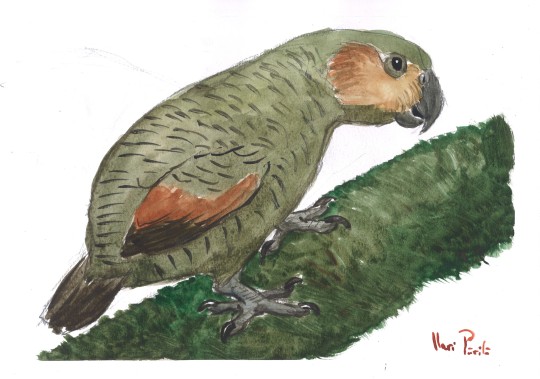
Artwork by @otussketching, written by @zygodactylus
Name Meaning: Unexpected Herculean Parrot
Time: 16 to 19 million years ago (Burdigalian stage of the Miocene epoch, Neogene period)
Location: St. Bathans Fauna, Bannockburn Formation, Aotearoa
Heracles was a truly alarmingly large parrot, related to modern day Kea, Kaka, and Kakapo, known from the fantastic avifauna of St Bathans. Standing more than two feet tall and weighing about fifteen pounds, this animal was much larger than any expected from the St Bathans fauna, which represented the initial colonization of Aotearoa (Zealandia) after it returned above sea level. Heracles is also the largest known species of parrot, ever. It was presumably flightless, though it is uncertain if it was nocturnal like its living relative the Kakapo. Its exact ecology is still uncertain, given the material known from Heracles is limited and its living relatives have very disparate ecologies, though it is possible it was omnivorous similar to the Kea and Kaka today. The St Bathans fauna lived in a freshwater lake system, in a subtropical emergent rainforest. Separated from land bridges, the fauna was dominated by birds, with early relatives of the Kiwi, New Zealand Wrens, Adzebills, and Wedge-Tailed eagles found in the fauna, as well as somewhat modern looking Moas. Smaller flamingos, large fruit pigeons, and a huge variety of geese and other waterfowl are known. In addition, frogs, tuataras, other lizards, crocodilians, turtles, and many different types of fish are known from this fascinating ecosystem.
Heliothraupis oneilli
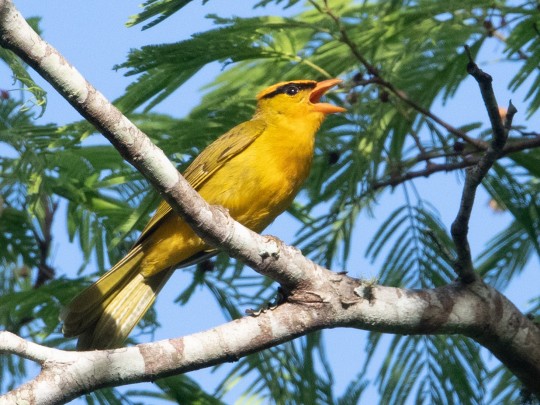
Photograph by John C. Mittermeier, written by @zygodactylus
Name Meaning: O’Neill’s Tanager of the Sun God Inti
Time: Unknown to the present, Holocene, Quaternary
Location: Western Bolivia and Southern Peru, South America
Rarely do we get to talk about a newly discovered living species of bird, but this is one of those excellent times! This bird, a bright yellow tanager with a distinctive black stripe across its eye, was found in the Neotropics - specifically in the Yungas region. Given that Latin America has the largest number of bird species in the world, it makes a certain amount of sense that we may have missed some! First spotted in the nineties, it was properly identified and described over the course of the 2010s. The distinctive appearance of this tanager lead to it being nicknamed the “Kill Bill Tanager”, in reference to its similarity to Uma Thurman’s yellow jumpsuit outfit. Distinct in appearance and population from other tanagers, it was deemed not only a separate species, but an entirely separate genus. It is migratory, breeding in the northern Machariapo Valley and going down to the eastern Andes for the nonbreeding season. It lives in deciduous forests, and breeds in bamboo grasses. It is a loud and vocal bird, making distinctive songs and choruses that happen long after the dawn chorus of most other birds. As it lives in a fairly isolated region of these countries, its habitat is not particularly threatened at this time.
#dmm rising stars#dmm#dinosaur march madness#dinosaurs#palaeoblr#birds#birblr#paleontology#bracket#march madness#polls#heracles#heliothraupis#round two
247 notes
·
View notes
Text

A map of the clans’s territories marking significant locations.
Location descriptions under cut:
1. The Moon Glacier
Said to be a piece of the moon itself, fallen from the sky onto the earth below. This massive chunk of ice slowly creeps across the ground, carved deep with crevices that glow blue from within. Traveling across this glacier will lead a cat to the Great Ice Sea, a stretch of cold, barren waste that no one but a god could survive on alone.
2. Iceclan’s Camp
If one scales the mountain that lies south of the glacier’s maw, they will find the narrow entrance to a cave between where ice and stone meet. Within this small cave lies the denizens of Iceclan, who all bed down together in the middle of the cavern.
3. The Moonlight Cavern
Deep in the cave where Iceclan makes their camp lies the entrance to a tunnel that extends into the mountain. This tunnel serves as the resting place for Iceclan’s dead, but also leads across the width of the mountain to where the glacier runs against the other side. A traveling cat is greeted with a wall of ice that stretches the far side of the cavern, and the sound of dripping water and the creaking groan of the glacier echoes off the walls. Light filters through the ice, flooding the cave with a haunting blue light. But in this stunning cavern, the first thing that will catch a cat’s eye is a dark shape suspended in the ice. Backed by a blue glow, the clear silhouette of an ancient cat skeleton sits frozen in the middle of the wall. A fallen god, preserved forever in moonlight, a link between cosmic beings and the cats of the mortal world.
4. The River
Fed by the meltwaters of the glacier, the River runs southeast through the mountains for several miles before joining the Bay. The land around it is flat, bordered by broad stretches of gravelly terrain.
5. Brookclan’s Camp
At the base of the north mountain, alongside a chilly stream fed by runoff and snowmelt, lies the Brookclan camp. To the camp’s north, a small waterfall leaps off the mountainface, continuing down south where it eventually meets the river. The ground here is slightly sloped, and clusters of bushes line the stream, in which the cats make their dens.
6. Gathering Rock
Resting just next to the river, surrounded by a wide swath of flat, pebbled ground, a huge flat stone rests alone in the valley. The cats of the clans gather here every full moon, spending the entire day feasting, playing games, and catching up with loved ones from across the clans. The clans’ leaders also use this time to coordinate with each other, gathering close to discuss strategic, survival, and spiritual matters.
7. The Bay
Stretching wide and blue toward the distant horizon, ringed by jagged mountains, the Bay lies at the heart of the surrounding region. Its shores are lined with a diverse array of fauna and flora, and its waters teem equally with nutrients and hazards.
8. Oceanclan’s Camp
Just inland of the Bay’s shore, through a tidal marsh into the hemlock woods, one can find the Oceanclan camp. The camp is pressed against the stony clifface and surrounded by dense, old-growth forest. In the middle of the clearing, a shallow freshwater pool is fed by a small waterfall, providing fresh water to Oceanclan’s denizens.
9. Stoneclan Camp South
Where a small stream runs between the south mountain and the edge of the town, the cat’s of Stoneclan have established their southern camp. The camp is often bustling with activity from passing couriers, hunting parties traveling from the North camp, and cats slipping into town to scavenge human goods.
10. The Town
Nestled between the surrounding mountain ranges, spreading out from the coast into the valley, one can find the hub of local human activity. Here lies much danger, in the form of humans, with their prying eyes, their grasping paws, their chemicals and roaring deadly machines. But where there is danger there is also resource: fish from the harbor, stolen human trinkets, information and news from local housecats. Here is where the domestic cats of the clans can return to their roots, a refuge from nature’s ruthless grasp.
11. Stoneclan Camp North
Stoneclan’s North camp sits within a small grassy meadow, settled beside a wide stream, only a stones throw away from the humans’ railroad tracks. The cats here make dens using scraps of human metal and other industrial waste, and will sometimes make fires for warmth, the smoke plumes hidden under the cover of night.
12. Bear Lake
If one goes inland, a few miles northeast of the clans’ territories, a cat may spot a break in the dense forest. There, one can step onto the shore of Bear Lake, gazing across the impressive expanse of water. The lake and the surrounding woods provide an abundance of herbs and wildlife (both passive and hostile). Due to its distance from the clans’ center, the lake is not frequented often, but serves as a location for summer fishing trips by cats from Brookclan and Stoneclan.
13. Captain’s Shack
Deep within the woods a few miles south of Bear Lake, a small, dilapidated cabin sits alone in a clearing. A narrow stream runs beside it, and a tiny, well-kept garden lies between. This is the home of Captain, an old cat who has lived here for decades. She enjoys crafting and collecting, and will often trade her wares with Clan cats in exchange for food or assistance with her garden. She’s also known to brew a special drink out of valerian and silver vine that often leaves cats with a pleasant buzz.
#foregoing the location images for now since they’re taking a while to draw#will add them later#shout out to google earth for serving as the base for this map lol#hopefully its not too hard to read this#map#brookclan#oceanclan#iceclan#stoneclan#locations#info
177 notes
·
View notes
Text



A Shoo-in Shoebill Stork
The shoebill stork, also known as the whalebill stork or Balaeniceps rex is in fact not a stork at all, but a long-legged wading bird belonging to the family Pelecaniformes. This species can be found in the central African tropics, from southern Sudan to northern Tanzania. Within this range, they mainly inhabit freshwater swamps and dense marshes, particularly those with deep water large reed beds.
Balaeniceps rex is often referred to as a dinosaur among birds due to its fearsome appearance. The average individual stands 1.1-1.4 m (3.6-4.5 ft) tall and has a wingspan of 2.3 to 2.6 m (7.5 to 8.5 in). However, adults are quite light, weighing only 4 to 7 kg (8.8 to 15.4 lb). Males tend to be larger than females, but otherwise the two sexes look identical. Adults have dark grey plumage with a lighter belly and darker wings. Their most striking feature is their beak, which is extremely large and can be said to resemble a wooden show (hence the name).
The shoebill's beak is very useful for catching its primary prey: fish. B. rex consumes a variety of species, including lungfish, catfish, and tilapia, as well as non-fish items like water snakes, frogs, turtles, mollusks, and even young crocodiles. Shoebills typically stalk their prey, or stand perfectly still and wait for their prey to come to them, before quickly snatching it up and decapitating it with the sharp edges of their beaks. Because of their large size and strong bills, adults are seldom prey for other animals, and they defend their nests fiercely from predators like snakes and other birds.
Outside of the breeding season-- and even during it-- shoebills are extremely territorial. Not only do they chase potential predators away from their nests, both males and females will fiercely defend their territory from other shoebills.
Breeding begins in the dry season, typically in in May, and lasts until about October. Once a male and female form a pair, they remain together for the duration of the mating season. They build a nest from floating vegetation, and 1-3 eggs are cared for by both parents; in addition to being incubated for warmth, one parent may also occasionally pour a beak-full of water over the eggs to keep them cool during the hot summer day. The eggs hatch about 30 days after being laid, and young are fed continuously-- though usually only one chick survives to adulthood. At 125 days old they become fully independent and leave to establish their own territories. The average individual can live up to 35 years in the wild.
Conservation status: The IUCN lists the whalebill stork as Vulnerable. Current wild population estimates sit at about 5,000-8,000 individuals. Primary threats include poaching for the zoo trade and consumption, habitat destruction, and pollution.
If you like what I do, consider leaving a tip or buying me a kofi!
Photos
Santiago Caballero Carrera
George Amato
Mana Meadows
#shoebill stork#Pelecaniformes#Balaenicipitidae#wading birds#birds#wetlands#wetland birds#freshwater fauna#freshwater birds#africa#central africa#animal facts#biology#zoology#ecology
159 notes
·
View notes
Text
Spectember D26: Break a biological record

Some hundreds of millions of years far into the future around 300 million years hence, after the formation of a big supercontinent, one that was not predicted to form, a lot of existing terrestrial and marine fauna look so alien compared to the animals that once man witnessed as the difference is as much as a human being would have to the first terrestrial tetrapod. Phylogenetically speaking many of those animals would be related to something like a crown, a snake, a varanid, a goby, a frog, a bat and so on but they are totally anatomically, morphologically and physiologically far from those, mammals and birds are a fraction of what they were, more mole or reptile like, varanids and frogs suffered of varied radiations and now they have been as much diverse as how dinosaurs and synapsids went through the Mesozoic and Cenozoic, and small fishes survived and radiated from freshwater species over and over from different mass extinctions, and just for matter of convergence they looked something like the modern species man saw, but they aren’t anatomically close to those.
In land mammals are just small and ectothermic creatures, in the ocean however one lineage managed to thrive as large swimmers, is not like any other group however, they have lost their forelimbs, their tails barely help them to swim and often depending of the species they have a rigid fluke or a seahorse-like prehensile tail, they managed to re-evolve some structure similarly to gills from a part of a nose cavity, a result of its proper ontogenic development as they did born not fully developed. These aren’t descendants of placentary mammals, but marsupials, a lineage that stood almost unchanged for many dozens of millions of years in the Americas and took a turn after the major calamities through the last 200 million years that drove their group to become reptile like, adopt peculiar adaptations for their lethargic metabolism and ended up in this stage, these aquatic animals were the last descendants of the opossums.
The Scorn Figoeq are a twisted form of the more seahorse-like herbivorous relatives that lives in the surfaces, living at depths of 4000 to 5000 meters under the surface is by far the deepest species of tetrapod that has ever lived, the deepest mammal to have diver so low under the ocean. It adopted the lifestyle of the already gone anglerfishes as well some other deep-water fishes, is among the last of an experimental lineage of the Figoeqs (Derivation of Figoeqqus or "shaped like horse") that tried to become pelagic planktonic feeders which ended up becoming extinct in the last 50 million years, remaining as a relic of that group. With 25 cm long, anything that could be considered mammal like only is exposed by looking at the embryo of this species as it starts with the basics of mammal anatomy, but reaching adulthood they resemble a mix of a jelly and a bizarre abyssal fish, with their short body, large head with a deep gelatinous cover that protects part of its head and eyes that now grow inside the flesh, with long dorsal spines that helps it to stabilize while swimming, their long hind flippers that look more like ray fins, and the tail that has grow a fluke to push it slowly across the darkness of the abyss.
57 notes
·
View notes
Text
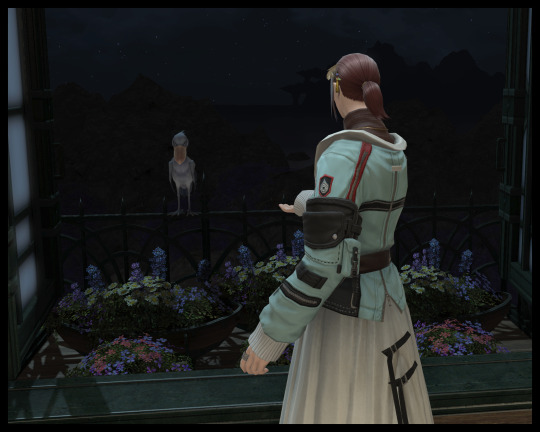
I can really hear him making kiss-kiss noises while trying to coax the shoebill into his room with the handheld promise of a few broken-up cream crackers. Of course, the shoebill's diet primarily consists of fish and other aquatic fauna that it forages for itself out of freshwater marshes, but Sethys wouldn't know that.
In any case, he senses something familiar about the bird but the feeling is vague and he can't quite place it.
21 notes
·
View notes
Text
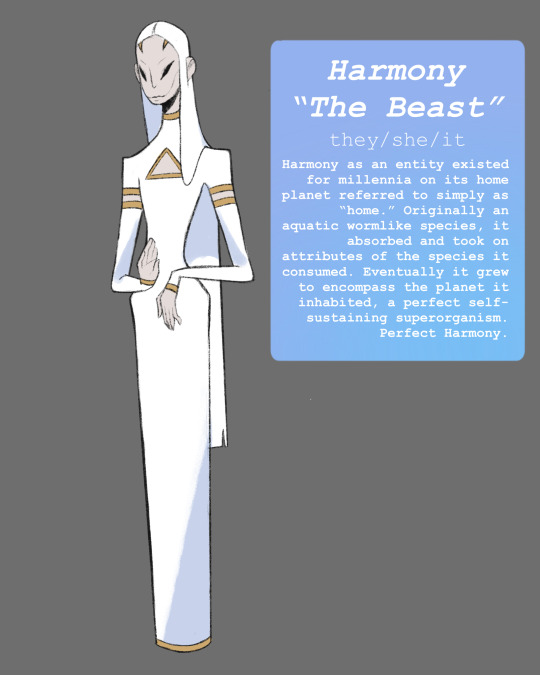

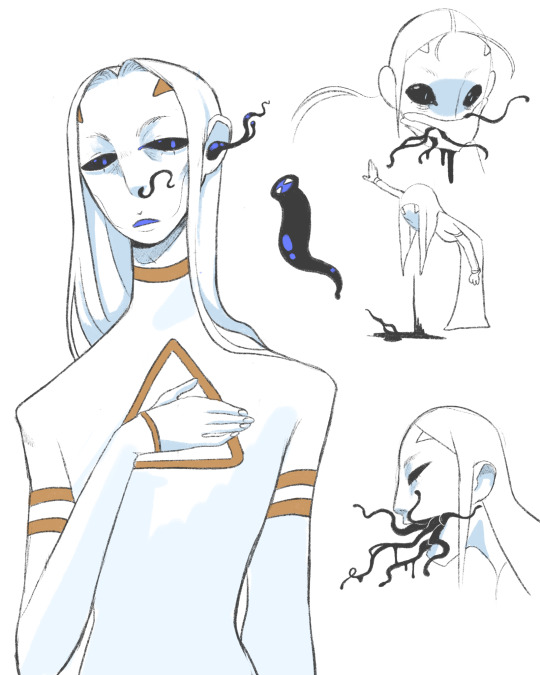
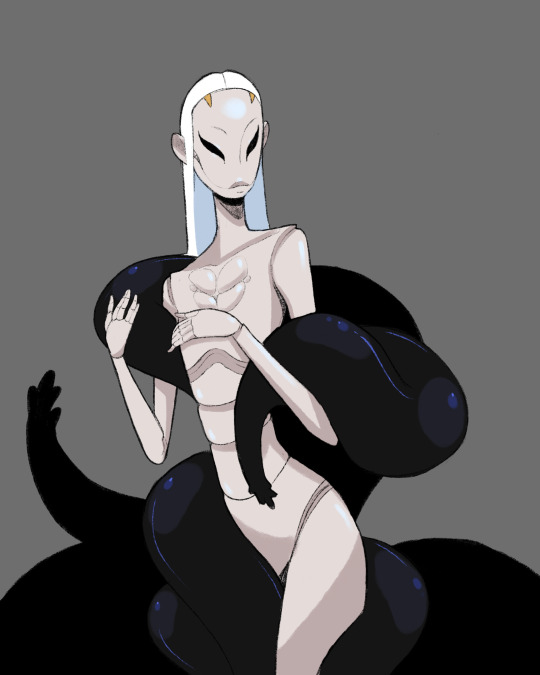
Character for my thirst sword lesbians campaign. She’s made of worms 💙
Harmony as an entity existed for millennia on its home planet, originally an aquatic worm like species, it absorbed and took on attributes of the species it consumed. Eventually it grew to encompass the planet it inhabited, a perfect self-sustaining superorganism. Perfect Harmony.
Some many years ago, a small spacecraft landed on the planet, crewed by no more than a half dozen members, in search of local flora and fauna to sell on astral black markets. The crew was consumed almost immediately, assimilated into the slimy embrace of Harmony, and with them a spark of intelligence began to grow. Their bodies were piloted back to their homeworld, the ships cargo hold full of black ichor.
Present day
Harmony has amassed power through sheer numbers to the status of a royal house, the House of Harmony. A house of one mind, a board of directors always in agreement. A thousand voices chorused in perfect humming unison.
Harmony’s current host chosen to act as galactic emissary and diplomat to the great houses is the body of Nymphia. A member of an aquatic insectoid race, chosen for her otherworldly beauty and her species ability to unhinge their lower jaw to extend and catch prey. Similar to a dragonfly nymph native to the freshwater biomes of earth.
23 notes
·
View notes
Text
Slugcat Ocs P2
The Matriarch: You are the Matriarch , an old slugcat by anyone’s standards, but one who’s led their tribe through some of the harshest times imaginable. You seek to make one final push and take back the city atop Dreaming Deeply from the predators, scavengers, and defense sentries so your people can live without fear of the rain. Bring your tribe into war and train a successor in the chance you don’t make it.
Goal: retake the Sleepless City and bring prosperity to your tribe. Additionally teach your successor everything they need to be a better leader than even you were.
Starting area: The Fairweather Plains, a massive sprawling plain tormented by nearly constant rains, your tribe has made a living underground in this place, but you wish to live amongst the clouds once more.
Color: Pale orange with many many scars. You need very little food for a slugcat and even in your old age stand far taller than those around you, tall enough in fact to scare off smaller predators.
Other: You may be able to convince the iterator to join your side and turn the cities defenses against those inhabiting it currently.
The Mariner: You are the Mariner, a purposed organism created by Built Slightly Sideways and tasked with repairing a leak of void fluid in her intake system at the bottom of the lake as well as reinforcing the crumbling rock shelf on which she sits. It’s quite the large task for such a small being. None will thank you for your duty, not your sacrifice, but it must be done nonetheless. Keep your eyes peeled and your tail ready, things are not as they seem in the deep and the waters teem with hungry mouths.
Goal: repair the damage to BSS’ structure and return to her with the good news.
Starting area: The Shallows, a teaming freshwater coral reef dense with sponges and other filterfeeders. Predators here are few and far between, but be thoughtful when sliding into gaps between the coral as Coiling Venipedes are always waiting for another foolish morsel.
Colors: Black and white counter shading, you have water breathing abilities greater than even the rivulet, however you are well and truly a creature of the water and as such leaving the lake for too long will see you dehydrate and eventually die. You’ve been cybernetically augmented with all of the tools you’ll need to fix BSS, including a plasma cutter that can be used to melt through tough metal doors.
Other: you have the ability to send out a sonar ping that highlights the outlines of creatures and structures within a certain radius, this is especially helpful in the deepest darkest reaches of the lake.
The Stray: You are the Stray, you have been following a trail of memories that are both yours and not, they’ve lead you through many dangerous lands and most recently to the base of an Iterators(Applied Blasphemy) structure. Something about it feels familiar to you and your memories tell you to seek out the being inside of it. Follow your fractured thoughts and reunite with a very very old friend.
Goal: Piece together exactly who you once were and have one last conversation with your old friend. Additionally Applied Blasphemy may send you out on some errands, it’s only fair that you pull your weight if you insist on living in their can.
Starting area: Left Leg, one of the main supports of Applied Blasphemy and the one most in need of repairs, you’ve been hibernating in a den inside the leg. Something about this space seems familiar to you.
Color: Gray with lighter gray stripes and the traditional tabby m on your forehead. You’re smaller than most slugcats and can fit into gaps others cannot. Additionally you can somehow read pearls and ancient texts without help, how interesting.
The Botanist : It’s said that in places with high karmic imbalance fauna and flora twist into strange new forms. Of course you care little for the fauna, but the flora… well that merits careful exploration. And perhaps taste testing. Regardless you’ll be sure to bring samples back to your tribe, maybe you’ll even be able to find something to heal your wounded leader.
Goal: you’ve ventured far and farther in search of a cure to the wounds the leader of your tribe sustained defending her people. Your goal is to gather karma flowers and to find the fabled void fruit while avoiding predators and perhaps learning about the history of the land on which you stand.
Starting area: the Hazy spire, this area is just outside of the rains of Speaks Through the Clouds. This area is marked by chilling fogs that make seeing things far away a struggle and provide predators ample hiding places. The ground is slippery and blanketed in dense clumps of moss. In this campaign you’d be exploring the areas around STC and likely venturing into his structure and city .
Color: a dark green slugcat with small white flowers in their fur that bloom when predators are near.
Other: there’s a small chance that during your cycles playing this cat you might wake up at night and be forced to contend with a very different world. Strange beings lurk in the night, but even stranger plants bloom then. You can also craft potions/remedies with various effects from plant parts you store in your satchel, these effects can range from a strong stench that deters lizards to making yourself temporarily poisonous enough that a vulture would drop you, to increased health and movement speed for the cycle at the cost of being tired the next cycle.
12 notes
·
View notes